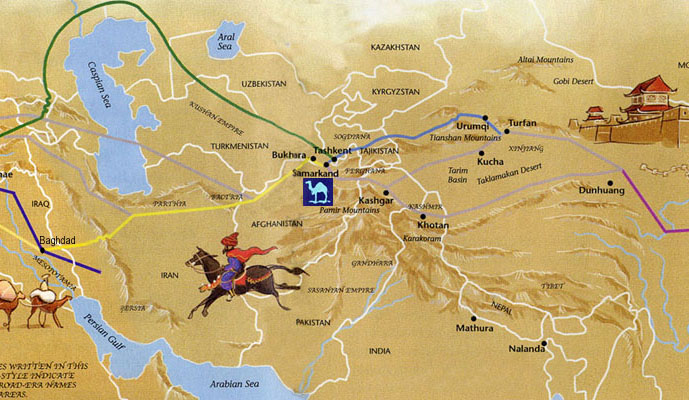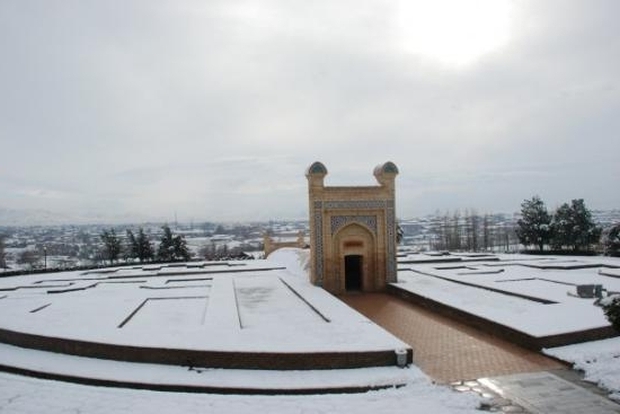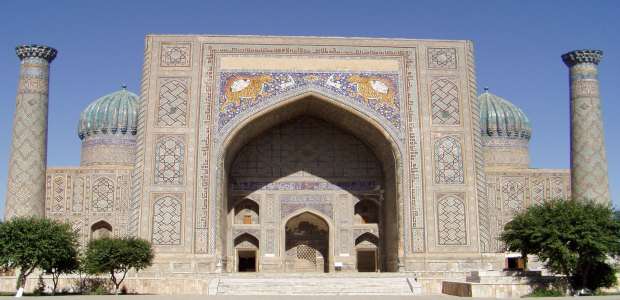The fabled city of Samarkand, at the hub of the old trade routes of Central Asia, has attracted poets, pilgrims and plunderers across deserts and mountains for more than 2000 years. As the sunlight reflects off its richly decorated mosques and minarets, the city gleams like a great golden beacon that can be seen for miles over the surrounding plains.
In ancient and medieval times, Samarkand stood at the junction of the Silk Road leading from China to the Mediterranean and the trade route from India to the west. Its name still evokes dreams of distant lands, great riches and exotic good and has inspired verse by Marlowe, Milton, Keats and Goethe.

One of the oldest cities in Central Asia, Samarkand is an oasis irrigated by canals from the Zarafshan River. In 329 BC, when it was known as Maracanda and was capital of Sogdiana, a part of the Persian Achaemenid Empire, the city was captured by Alexander the Great, King of Macedonia, while he was en route to India. Later it came under the rule of the Turks, Arabs and Persians, but it was the repeated surges of nomadic armies in medieval times that had the most influence on the fortunes of Samarkand.
The first of these invasions was led by Genghis Khan (meaning ‘Universal Ruler’) a minor Mongol chieftain who eventually brought all the nomadic tribes of Mongolia under his command. He then turned his attention to the settled people beyond the borders of his realm and began a campaign of plunder and conquest that resulted in the establishment of the great Mongol Empire, stretching from the Adriatic Sea to the Pacific Ocean. The Mongols were superb horsemen, and under Genghis Khan’s inspired leadership proved an unstoppable force. After laying waste to Beijing in 1215, Genghis Khan took control of the Silk Road and in 1220 besieged Samarkand. A century later, when the Arab traveler Ibn Battuta arrived at the city, it still lay in ruins.
The second nomadic leader of importance to Samarkand, Timur Lenk, or ‘Iron Limper’ (a byname referring to a leg injury caused by an arrow), also known as Tamerlane, had a more positive influence on the city. He was born near Samarkand in 1336, and established himself as sovereign of the Chagatai line of khans – a dynasty started by Genghis Khan’s second son. By 1367 the Mongol Empire was in decline and Timur was determined to become the leader who would restore it to its former glory. He proceeded to launch a succession of military campaigns from the Black Sea to the Indus Valley, ransacking towns and villages, massacring whole populations and building pyramids with their skulls. No mercy was afforded to those he captured; Timur spared only the lives of craftsmen from Azerbaijan, Isfahan, Shiraz, Delhi and Damascus, whom he dispatched to his capital.
These men transformed Samarkand into a city of lofty minarets and graceful, glistening domes, a capital worthy of a great emperor. Timur was a keen student of architecture and had been impressed by the dome atop the central mosque of Damascus. He had it copied for the Gur-i-Amir his magnificent tomb in Samarkand. The style continued to be used by his successors, such as the Uzbeks, who built this dome on the shirdar madrasa. Later, the idea of using domes to enhance buildings spread north to Russia an south to India.

Between military campaigns, Timur camped outside the city in luxurious silken tents to direct the building work. Every surface was covered with multi-coloured glazed tiles in spectacular mosaic patterns which reflected the light, so that Samarkand shimmered in the sunlight like a jewel.
On his triumphal return from India, Timur decided to proclaim his greatness by building the largest mosque in the Islamic world. The mosque, called Bibi Khanum, was started on the astrologically auspicious day of 11 May 1399, and was completed in five years using the skills and energy of 200 craftsmen, 500 labourers and 95 elephants. Its huge dome still dominates the city, and in the courtyard stands a lectern that once held a 6ft (2m) Koran.

Timur Lenk died in 1405, while on a campaign in China, and was buried in Samarkand, in the Gur-i-Amir (the Ruler’s Tomb), originally built by him for one of his grandsons. The simple stone laid over him by another grandson, Ulugh Beg, is the world’s largest piece of jade, from Chinese Turkestan. Under Ulugh Beg, Samarkand became a cultural and intellectual centre of the age. The ruler built a grand two-storeyed madrasa, or theological college, decorated with a beautifully carved facade, that occupied the whole of the west side of the central square.
Ulugh Beg’s passion was science and astronomy. He built a three-storey observatory on a hill near the old city and the remains still stand today. It housed a double sextant – used for observing the Sun, Moon and planets –which had a radius of 133ft (40m) and was mounted on a bronze track calibrated in degrees.

Ulugh Beg lured some of the finest intellects to the city, not only to the college, but also to his large observatory, which contained the latest technological equipment for observing the heavens. There the first precise star tables, plotting the positions of the stars, were calculated. The observatory made a fundamental contribution to the science of astronomy with the production of the Zij-i-Gurkani, the first precise star tables, completed in 1437. The correct length of a year was also calculated there.
In 1449, Ulugh Beg was assassinated at the instigation of his son. He was laid to rest beside his grandfather in the Gur-i-Amir. Samarkand slowly declined as the importance of the Silk Road diminished and China closed its borders under the Ming Dynasty. The city became increasingly vulnerable to attacks by the Golden Horde (a group of Turko-Mongol tribesmen), led by Khan Uzbek, and was finally conquered in 1500.
For all its brutality, the dynasty founded by Timur was responsible for the rich artistic and intellectual renaissance in Samarkand in the 14th and 15th centuries, which made important contributions to Islamic architecture and to the science of astronomy. By the 18th century the city’s fortunes had so declined that it was actually uninhabited for 50 years from 1720. In the 19th century, the region came under Russian rule. As a provincial capital and with the coming of the railways in 1896, Samarkand began to recover economically and once again became an important centre, this time for the export of agricultural produce. Today it is part of an independent Uzbekistan.



































